Complete Solutions to EXERCISE of chapter QUADRILATERALS of Class 9 book with complete answers and questions
| Class 9 | MATHS |
| Chapter | QUADRILATERALS |
| MODERN PUBLICATION | EXERCISE |
| Number Of Questions | 100 |
| Academic Year | 2023-24 |
Three angles of a quadrilteral are respectively `50^@` and `110^@` and `100^@` . Find the fourth angles.
View SolutionThe angle of a quadrilateral are in the ratio 2: 4: 5: 7. find the angles.
View SolutionIn the quad. ABCD is a point inside it. Find that OA+OB+OC+OD>AC+BD.
View SolutionIn the fig. `BLbotAC` and `DMbotAC`. If BL=LM prove that AC bisects BD

View SolutionIn the fig. ABCD is a square and `anglePQR=90^@` PB=QC=DR, prove that:QB=RC
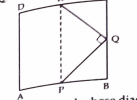
View SolutionIn the fig. ABCD is a square and `anglePQR=90^@` PB=QC=DR, prove that:PQ=QR
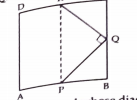
View SolutionIn the fig. ABCD is a square and `anglePQR=90^@` PB=QC=DR, prove that:`angleQPR=45^@`
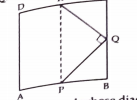
View SolutionABCD is a quadrilateral whose diagonals AC and BD intersect at O, prove that:
(AB+BC+CD+DA)>(AC+BD)
View SolutionABCD is a quadrilateral whose diagonals AC and BD intersect at O, prove that:
(AB+BC+CD+DA)>2(AC+BD)
View SolutionA diagonal of a rectangle is inclined to one side of the rectangle at `25^@`. The acute angle between the diagonals is
View SolutionIn a parallelogram, prove that sum of any two consecutive angles is `180^@`.
View SolutionIf an angle of a parallelogram is two thid of its adjacent angle, find the angles of the parallelogam.
View SolutionIn the fig. ABCD is a parallelogram in which `angleDAB=60^@` and `angleDBC=80^@` find `angleCDB` and `angleADB`

View SolutionIn the fig. ABCD is a parallelogram in which `angleBAO=35^@`, `angleDAO=40^@` and `angleCOD=105^@`

find that:`angleABO`?
View SolutionIn the fig. ABCD is a parallelogram in which `angleBAO=35^@`, `angleDAO=40^@` and `angleCOD=105^@`

find that:`angleODC`?
View SolutionIn the fig. ABCD is a parallelogram in which `angleBAO=35^@`, `angleDAO=40^@` and `angleCOD=105^@`

find that: `angleACB`
View SolutionIn the fig. ABCD is a parallelogram in which `angleBAO=35^@`, `angleDAO=40^@` and `angleCOD=150^@`

find that:`angleCDO`
View SolutionThe diagonals of a rhombus are perpendicular to each other .
View SolutionThe diagonals of a rectangle ABCD meet at o and `angleBOC=44^@` and find `angleOAD`.
View SolutionABCD is a rectangle with `angleABD=40^@` determine `angleDBC`.
View SolutionThe sides AB and CD of a parallelogram ABCD are bisects at E and F. prove that EBFD is parallelogram.
View SolutionTwo adjacent angles of a parallelogram have equal measure. Find the measure of each of the angles of the parallelogram.
View SolutionThe lengths of the diagonals of a rhombus are 10 cm and 8.2 cm .Its area will be :
View SolutionIn the fig. ABCD is a square M is the mid point and `PQ bot CM` meets AD at and CB produced prove that
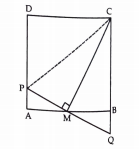
PA=BQ?
View SolutionABCD is a square M is the mid point of AB .`PQbotCM`. PQ meets AD at P and CB at Q prove that
CP=CQ
View SolutionABCD is a parallelogram. L and M are points on AB and DC respectively and AL = CM. Prove that LM and BD bisect each other.
View SolutionIn Fig. .
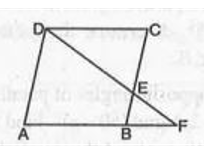
ABCD is a parallelogram and E is the mid-point of side BC. If DE and AB, when produced meet at F, prove that AF = 2AB.
View SolutionIn the fig. ABCD is a parallelogram and X,Y and Z the points on diagonal BD such that DX=BD prove that CXAY is a parallelogram.

View SolutionIn the fig ABCD is a parallelogram in which E and F are mid points of AB and CD respectively. Prove that the line segments CE and AF intersect diagonal BD
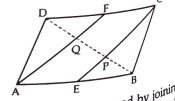
View SolutionProve that the figure formed by joining the points of the adjacent sides of a quadrilateral parallelogram.
View SolutionProve that the figure formed by joining the mid-points of the pairs of consecutive sides of a quadrilateral is a parallelogram.
View SolutionIn triangleABC, AD is the median through A and E is the mid point of AD. BE is produced so as to meet AC in F. prove that `AF=1/3AC`
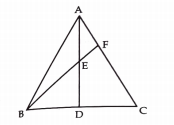
View SolutionABCD is a parallelogram. P is any point on AD, such that `AP = 1/3AD` and Q is a point on BC such that `CQ = 1/3AD` . Prove that AQCP is a parallelogram.
View SolutionP is the mid point of side AB of a parallelogram ABCD. A line through B parallel to PD meets DC at Q and AD produced at R. prove that
AR=2BC.
View SolutionP is the mid point of side AB of a parallelogram ABCD. A line through B parallel to PD meets DC at Q and AD produced at R. prove that
BR=2BQ.
View SolutionProve that the line joining the mid points of the diagonals of a trapezium is parallel to the parallel sides of the trapezium.
View SolutionIn the fig. two points A and B in on the same side of a line XY. If `ADbotXY, BEbotXY` and C is the mid point of AB. Prove that CD=CE
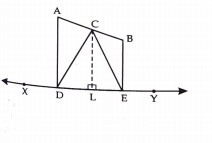
View SolutionIn the fig. ABCD is a trapezium in which AB||DC and AD=BC. IF P,Q,R,S are respectively the mid points of BA,BD and CD,CA, then show that PQRS is a rhombus.

View SolutionABCD is a trapezium in which AB||DC and let E be the mid point of AD. Let F be a point on BC such that EF||AB. Prove that

F is mid point of BC.
View SolutionABCD is a trapezium in which AB||DC and let E be the mid point of AD. Let F be a point on BC such that EF||AB. Prove that

`EF=1/2(AB+DC)`
View SolutionIn the fig points M and N divide AB of triangleABC into three equal parts. Line segments MP and NQ are both parallel to BC and meet AC in P and Q respectively. Prove that P and Q divide AC nto three equal parts
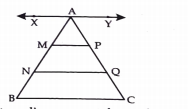
View SolutionProve that any line segment drawn from the vertex of a trianlge to the base is bisected by the line segment joining the mid points of the other sides of the triangle.
View SolutionThe figure obtained by joining the midpoints of the sides of a rhombus, taken in order, is
View SolutionDiagonals of the parallelogram bisect each other at right angles .
View SolutionName the quadrilateral formed in which two parallel of adjacent sides are of the same length.
View SolutionIn a quadrilateral PQRS, `angleP+angleS=180^@`. Name the type of quadrilateral it is?
View SolutionIn a parallelogram PQRS, write the sum angles of P and Q.
View SolutionABCD is a rectangle with `angleBCA=34^@` find `angleDBC`.
View SolutionThe perimeter of a parallelogram is 24 cm. if the large side measures 7.5 cm, what is the measure of shorter side?
View SolutionIn quadrilateral ABCD, AP and BP are bisector of `angleA` and `angleB` respectively, then find the value of x

View SolutionIf three angles of a quadrilateral are `110^@,65^@` and `105^@` then find the measure of the fourth angle.
View SolutionOpposite angles of a quadrilateral ABCD are equal. If AB=4 cm determine CD.
View SolutionCan all the angles of a quadrilateral be right angles? Give reasons for your answer.
View SolutionIn a parallelogram PQRS, if `angleS=125^@`, find the measure of `angleP`.
View SolutionIf the angles of a quadrilateral are in the ratio 3:5:9:13 , then find the measure of the smallest angle.
View SolutionIn a parallelogram PQRS, `angleP=(3x-20)^@,angleQ=(y+15)^@,angleR=(x+40)^@`, then find the values of x and y.
View SolutionIn the fig. PQRS is a trapezium. Find the values of x and y

View SolutionIn the fig. ABCD and AEFG are the parallelogram if `angleC=58^@`, find `angleF`

View SolutionPQRS is a parallelogram. Find the values of x and y

View SolutionDiagonals of a parallelogram ABCD intersects at O. if `angleBOC=90^@` and `angleBDC=50^@`. Then find `angleOAB`.
View SolutionIn the fig. ABCD is a rectangle in which diagonal AC is produced to E. if `angleECD=146^@` if find `angleAOB`

View SolutionABCD is a trapezium with parallel sides AB = a cm and DC = 6 cm E and F are the mid-points of the non-parallel sides. The ratio of ar (ABFE) and ar (EFCD) is
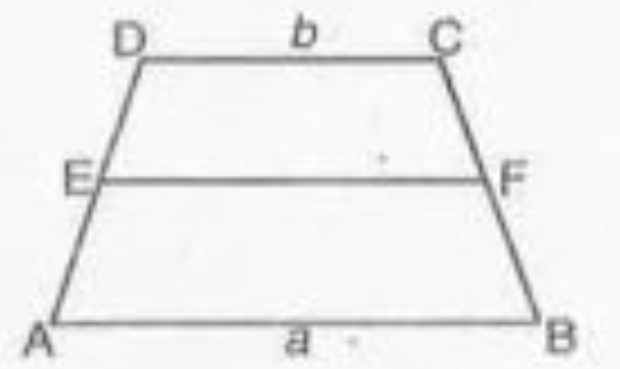
View SolutionTrue/false
If all the sides of quadrilateral are equal, then it is a rhombus.
View SolutionTrue/false
Diagonals of a paralllelogram are perpendicular to each other.
View SolutionTrue/false
All the four angles of a quadrilateral can be obtuse angles.
View SolutionTrue/false
Diagonals of a rhombus are perpendicular but unequal.
View SolutionThe figure formed by joining the midpoints of the consecutive sides of a quadrilateral is ............... .
View SolutionTrue/false
If three angles of quadrilatera are `30^@,80^@,110^@` then the fourth angle is `120^@`.
View SolutionIn a parallelogram, sum of any two adjacent angles is `180^@`.
View SolutionTrue/false
Consecutive angls of a parallelogram are complementary.
View SolutionTrue/false
If in a quadrilateral one pair of opposite sides are parallel, the quadrilateral is a rhombus.
View SolutionTrue/false
If one angle in a parallleogram is a right angled, then it is necessary a rectangle.
View SolutionFill ups
In a parallelogram the opposite sids are……………. .
View SolutionFill ups
A square, rectangle and rhombus are……………. .
View SolutionFill ups
In a parallelogram ……………bisect each other.
View SolutionFill ups
A quadrilateral is a parallelogram if both pairs of opposite angles is………………. .
View SolutionFill ups
If one pair of opposite sides are equal and parallel, then the figure is……………
View SolutionFill ups
Consecutive angles of a aprallelogram are…………. .
View SolutionFill ups
If consecutive sides of a parallelogram are equal, then its necessarily a…………….. .
View SolutionThe figure formed by joining the midpoints of the consecutive sides of a quadrilateral is ............... .
View SolutionThe bisectors of angles of a parallelogram from a :
View SolutionThe angles of a quadrilateral are in the ratio `3 : 4 : 5 : 6`. The respective angles of the quadrilateral are :
View SolutionIn a quadrilateral ABCD, if AO and BO are the bisectors `angleA` and `angleB` respectively, `angleC=70^@` and `angleD=30^@` then `angleAOB`=
View SolutionThe figure formed by joining the midpoints of the consecutive sides of a quadrilateral is ............... .
View SolutionThe figure formed by joining the mid points of the adjacent sides of a rectangle is
View SolutionThe figure formed by parallelogram is `24^@` less than twice the smallest angles, then the largest side angle of the paralellogram is
View SolutionFind the measure of all the angles of a parallelogram, if one angle is `24^@` less than twice of the smallest angle.
View SolutionThe consecutive sides of a quadrilateral have
View SolutionWhich of the following quadrilateral is not a rhombus?
View SolutionThe bisectors of any two adjacent angles at a parallelgoram intersect is
View SolutionThe figure formed by joining the mid points of the adjacent sides of a paralellgoram s
View SolutionThe figure formed by joining the mid points of the adjacent sides of a paralellgoram s
View SolutionIn one angle of a prallelogram is `24^@` less than the smallest angles, then the measure is largest angle of the parallelogram is
View SolutionABCD is a parallelogram and E and F are the centroids of triangle ABD and BCD respectively then EF=
View SolutionIn Fig. .

ABCD is a parallelogram and E is the mid-point of side BC. If DE and AB, when produced meet at F, prove that AF = 2AB.
View SolutionIf the degree measures of the angles of quadrilateral are 4x,7x,9x and 10x what is the sum of the measures of the smallest angle are largest angle?
View SolutionThe diagonal AC and BD of a rectangle ABCD intersect each other at P. if `angleABD=50^@` and `angleDPC`=
View SolutionABCD is a rhombus such that `/_ACB = 40^@`. Then `/_ADB` is
View SolutionDiagonals of a parallelogram ABCD intersects at O. if `angleBOC=90^@` and `angleBDC=50^@`. Then find `angleOAB`.
View SolutionABCD is a trapezium in which `AB || DC`. M and N are the mid-points of AD and BC respectively. If AB = 12 cm, and MN = 14 cm, find CD.
View Solution
EXERCISE questions and complete solutions for chapter QUADRILATERALS of MODERN PUBLICATION of Class 9